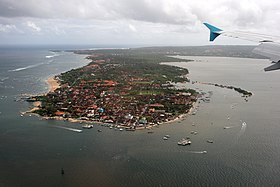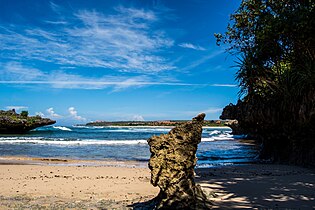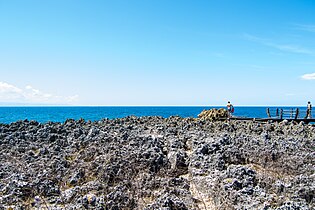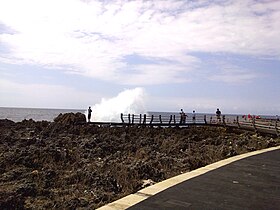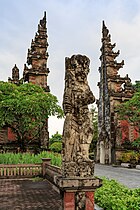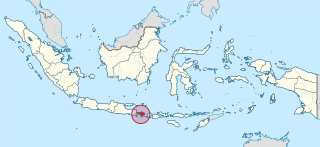
Bali is a province of Indonesia and the westernmost of the Lesser Sunda Islands. East of Java and west of Lombok, the province includes the island of Bali and a few smaller offshore islands, notably Nusa Penida, Nusa Lembongan, and Nusa Ceningan to the southeast. The provincial capital, Denpasar, is the most populous city in the Lesser Sunda Islands and the second-largest, after Makassar, in Eastern Indonesia. The upland town of Ubud in Greater Denpasar is considered Bali's cultural centre. The province is Indonesia's main tourist destination, with a significant rise in tourism since the 1980s, and becoming an Indonesian area of overtourism. Tourism-related business makes up 80% of the Bali economy.

Lombok is an island in West Nusa Tenggara province, Indonesia. It forms part of the chain of the Lesser Sunda Islands, with the Lombok Strait separating it from Bali to the west and the Alas Strait between it and Sumbawa to the east. It is roughly circular, with a "tail" to the southwest, about 70 kilometres across and a total area of about 4,607.38 square kilometres including smaller offshore islands. The provincial capital and largest city on the island is Mataram.
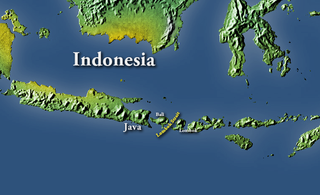
The Lombok Strait, is a strait of the Bali Sea connecting to the Indian Ocean, and is located between the islands of Bali and Lombok in Indonesia. The Gili Islands are on the Lombok side.

Denpasar is the capital city of the province of Bali, Indonesia. Denpasar is the main gateway to the Bali island, the city is also a hub for other cities in the Lesser Sunda Islands.

Tourism in Indonesia is an important component of the Indonesian economy as well as a significant source of its foreign exchange revenues. Indonesia was ranked at 20th in the world tourist Industry in 2017, also ranked as the ninth-fastest growing tourist sector in the world, the third-fastest growing in Asia and fastest-growing in Southeast Asia. In 2018, Denpasar, Jakarta and Batam are among of 10 cities in the world with fastest growth in tourism, 32.7, 29.2 and 23.3 percent respectively. The tourism sector ranked as the 4th largest among goods and services export sectors.

The Gili Islands are an archipelago of three small islands or Gili island triplets — Gili Trawangan, Gili Meno and Gili Air — just off the northwest coast of Lombok, Indonesia. The local name of these three islands is Gili Indah which means "small beautiful islands".
Badung Strait is a strait on the south east side of Bali in Indonesia. It lies between the islands of Bali and Nusa Penida. It is about 60 km long and 20 km wide.

Kuta is a tourist area, administratively an urban village (kelurahan), and the capital of Kuta District, Badung Regency, southern Bali, Indonesia. Kuta is a part of the Denpasar metropolitan area, 12 km (7.5 mi) south of downtown Denpasar. Originally known as a fishing village, it was one of the first towns on Bali to see substantial tourism, and as a beach resort remains one of Indonesia's major tourist destinations. It is known internationally for its long sandy beach, varied accommodations, restaurants and bars, and many renowned surfers who visit from Australia. It is near Bali's Ngurah Rai Airport.

Sanur is a coastal stretch of beach east of Denpasar in southeast Bali, which has grown into a little town in its own right. A 5.1 km (3.2 mi) area of Sanur's coastline, from Matahari Terbit Beach to Mertasari Beach, was reclaimed in 2008.

Candi Dasa, or often Candidasa is a seaside town on the eastern cost of Bali that rests on the edge of a fresh water lagoon, named Candi Dasa Lagoon. The town is centred around Jalan Raya Candida, where a number of hotels, restaurants, and shops line the main road. It is popular tourist stop, attracting divers and those looking for a more sedate alternative to the busy, nightclub filled Kuta area or the large, manicured resorts at Nusa Dua.

Lovina Beach is a coastal area on the northwestern side of the island of Bali, Indonesia. The coastal strip stretches from 5 km west of the town of Singaraja to 15 km west. Singaraja is the seat of Buleleng Regency. The Lovina area contains the small villages of Pemaron, Tukad Mungga, Anturan, Banyualit, Kalibukbuk, Kaliasem and Temukus. Although it has become more popular with tourists, it remains far quieter than the tourist hotspots of the island's south side.
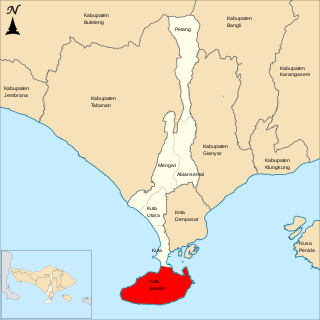
South Kuta is a district (kecamatan) within Badung Regency of Bali. It consists of Nusa Dua, a large peninsula projecting south from Bali island.

Nusa Lembongan is an island located southeast of Bali, Indonesia. It is part of a group of three islands that make up the Nusa Penida district, of which it is the most famous of the three islands of Nusa Penida, Nusa Lembongan, and Nusa Ceningan - known together as the "Nusa Islands". This island group, in turn, is part of the Lesser Sunda Islands.

West Lombok Regency is a regency of the Indonesian Province of West Nusa Tenggara. It is located on the island of Lombok and the administrative capital is the town of Gerung. The regency covers a land area of 922.91 km2 and had a population of 599,609 at the 2010 census and 721,481 at the 2020 census; the official estimate as at mid 2023 was 753,641.

Central Lombok Regency is a regency of the Indonesian Province of West Nusa Tenggara. It is located on the island of Lombok and the capital is Praya. It covers an area of 1,208.39 km2, and had a population of 859,309 at the 2010 census and 1,034,859 at the 2020 census; the official estimate as at mid 2023 was 1,099,211.

Pecatu is a village (desa) in South Kuta, Bali, Indonesia. Located in the western side of the Bukit Peninsula, its hilly landscape creates smaller, more isolated beaches than at Nusa Dua on the eastern side of the peninsula. It is popular with surfers and also with nudists. The Uluwatu Temple is also located at Pecatu.

Aerowisata is an Indonesian hospitality company based in Jakarta. It has five main businesses, consisting of Foodservice, Hotels, Travel, Transportation and Logistics. It is a subsidiary of Garuda Indonesia Group.
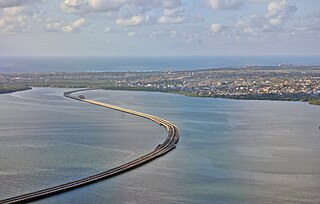
Bali Mandara Toll Road or Nusa Dua-Ngurah Rai-Benoa Toll Road is a toll road carried by a bridge stretching across the Gulf of Benoa. The 8.3-kilometre (5.2 mi) highway connects the city of Denpasar and South Kuta, Badung Regency, Nusa Dua and Ngurah Rai International Airport. It cost Rp 2.48 Trillion to construct and was intended to prevent traffic jams on the Ngurah Rai Bypass Road, previously the only road connecting areas of Bali on opposite sites of the airport. The Ngurah Rai Bypass Road, a land-based route, could not be widened because of the location of the airport runway; the new toll road was instead constructed over water.

A resort island is a hotel complex located on an island; in many cases one luxury hotel may own the entire island. More broadly, resort island can be defined as any island or an archipelago that contains resorts, hotels, overwater bungalows, restaurants, tourist attractions and its amenities, and might offer all-inclusive accommodations. It primary focus on tourism services and offer leisure, adventure, and amusement opportunities.


